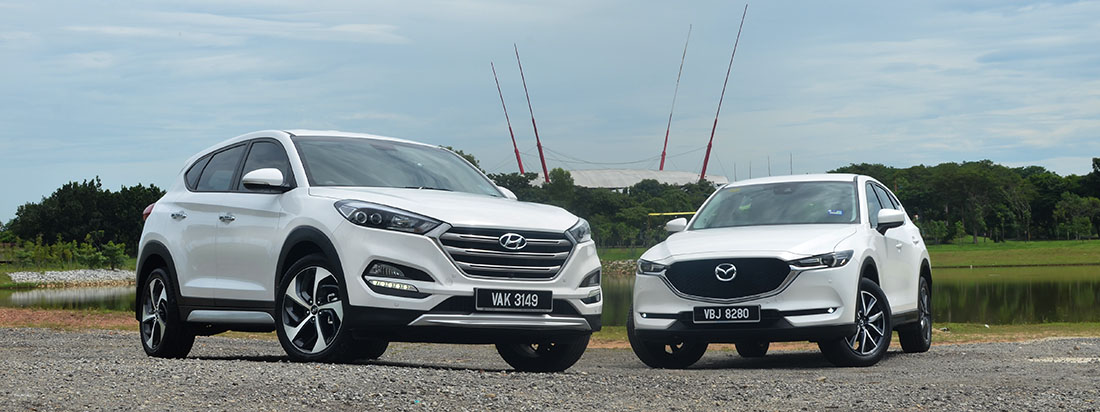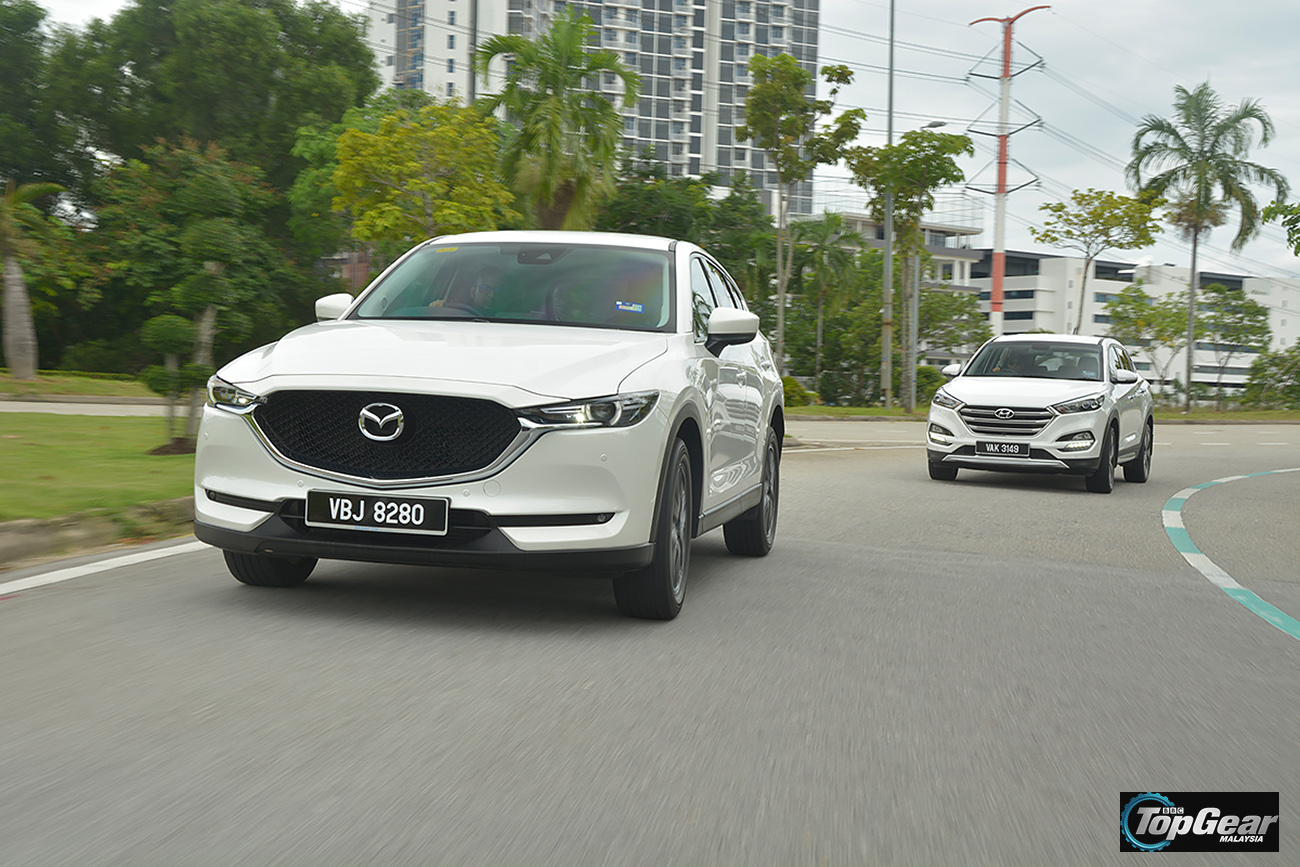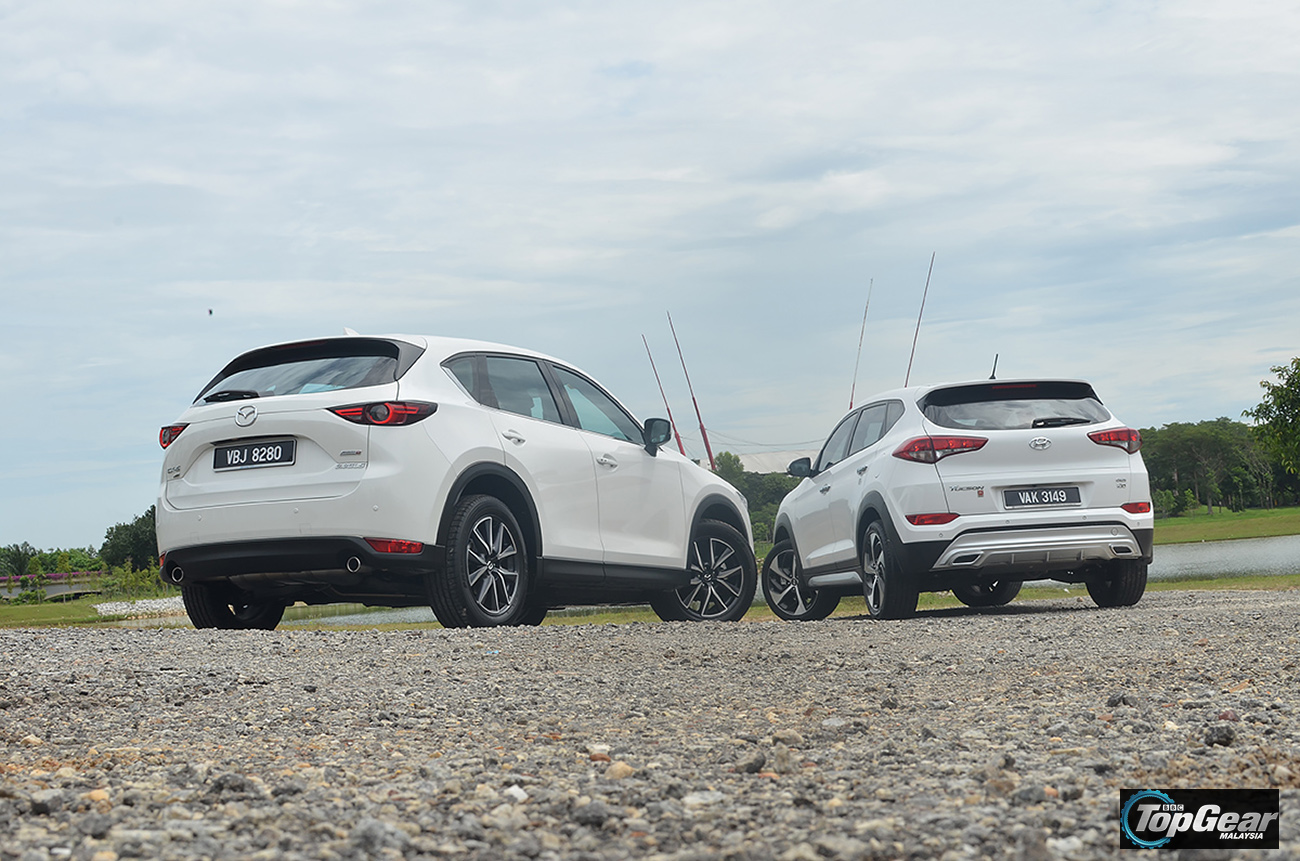Comparo: Mazda CX-5 vs Hyundai Tucson

Thoriq: So, why are we revisiting these SUVs again?
Daryl: Everyone wants a crossover these days. Buyers have stopped looking at executive saloons and are now fixated on higher ground clearance and rugged looks. It’s a massive detour in conventional buying habits for people who typically resist change.
T: How so?
D: Industry trends show that Malaysians can be creatures of habit. The sedan was revered as the definitive body shape for cars of all segments till recently. Even turbocharging and alternative fuels took some time to catch up. SUVs have overcome that hurdle and are now firm favourites in our market. But there’s still an element of challenge left to buyers.
T: Hence the diesels…
D: Exactly. So, you’ve had a go at the Mazda CX-5 in petrol and diesel formats in quick succession. Do you think diesel is still relevant in this day and age?
T: Yes. I have to admit, the SkyActiv-D unit is actually very pleasant. It has the typical abundance of torque you get from an oil burner from low down up to the mid-range. But give it the beans and you’ll be glad to find that it isn’t too ‘puff-less’ at the top. It still sounds like a truck, but a bit quieter thanks to the low compression ratio.

D: Agreed on all accounts. The peppiness of the SkyActiv-D is really nice. Access to 420Nm from just 2,000rpm justifies Bermaz’s decision to have the SkyActiv-D engine power its range-topping CX-5. The slight rattle that comes with it can irk drivers who’ve been driving petrols all their lives. But it’s an otherwise smooth powertrain overall – one that can give the 2.5 SkyActiv-G a run for its money.
T: If you think the CX-5 is noisy, the Hyundai Tucson CRDi is louder. It’s by far the more agricultural sounding of the two. But again, it drives plenty of torque from low down as you’d expect a turbodiesel to. Even though the Tucson makes 5bhp more (178bhp versus 173) its top end isn’t as strong as the Mazda’s. But the Korean number just feels a bit perkier on the move.
D: I’d describe the engine as being more linear in the way it builds and delivers its power. The two-litre CRDi is quite the workhorse, and it jives well with the amply weighted steering, producing a genuinely entertaining drive. Its dynamics are a bit old-school – no lightning quick responses or electronically aided inputs – but that’s what I love about the way the Tucson drives.
T: The Tucson’s suspension isn’t as refined as the CX-5’s is well-rounded. But it certainly is engaging to drive – a bit of a dummy, but sometimes you could use a little more ‘raw’ in life.
D: But is it better than the Mazda?
T: Oddly enough, the Mazda feels muted despite its dynamic chassis setup. But it does feel like the more refined SUV overall. It even has driver aids like lane keep assist, blind spot info, autonomous city braking and rear cross traffic alert, none of which is available in the Tucson. These are all features parked under Mazda’s i-Activesense umbrella.
D: Neat. And we haven’t got to how amazing the new CX-5 looks. I think it’s one of the most beautiful SUVs ever designed.
T: Honestly, I think the Tucson looks equally sharp and modern. But you’re right, the CX-5 is a much tastier looking car, especially with its full LED lighting and sharper lines. The wheels aren’t as swanky as the Hyundai’s kicks though.
D: Okay, exterior-wise, some debate is expected. But it’s a whitewash inside, where the Mazda looks so much better from every angle you can possibly absorb the cabin. There’s obviously much more thought put into the design of the CX-5’s interior. And every touch point feels more premium as well. Sure, there’s leather and soft-touch plastics in the Tucson, but its cabin is just a mixed bag of try-too-hard design cues and tacky tech (the rearview mirror-mounted screen just has to go) that just don’t gel. An easy win for Mazda here.
T: Stop right there. Yes, the CX-5 has the better looking interior but it’s just so cramped. The Tucson is more spacious. It’s easily the more practical of the two. And it has a powered tailgate! Take that, Mazda.
D: Wait, I’m confused. Whose side are you on now?
T: All things considered, the CX-5 does look like the best diesel Japan has to offer in the segment. But its intelligence and refinement come at a price – it’s nearly RM4k more expensive than the Tucson. It’s really a case of getting what you pay for, with the Tucson hampered by quality inconsistencies and lack of kit despite it giving the CX-5 quite a challenge in the drive department. It’s really hard to call, this.

D: Then let me call it for you. Your instincts were already leaning towards the Mazda CX-5 being the better all-rounder because it is. The only areas in which the Tucson edged the CX-5 were driving dynamics and practicality, but it’s a slim win in both cases. Technologically and aesthetically, the Mazda is in a different league. And there’s a uniformity between the CX-5’s many different sets of components that’s missing in the Tucson. It feels like it’s been designed and engineered under one roof in Hiroshima whereas some sectors of the Tucson look very ‘outsourced’.
T: The CX-5 is also the only diesel SUV with a 4WD option, isn’t it?
D: Yes, in all the debate we forgot to mention that both crossovers were tested in 2WD (FWD) formats. But unless you’re actually planning to take your new SUV off-road, the extra weight and reduced fuel efficiency aren’t really worth the added costs. Hyundai-Sime Darby Motors got it right by limiting an already niche powertrain to just one city-savvy variant. And for all the flak we’ve given the Tucson, I wouldn’t question the logic of those who’ve purchased one over something Japanese. As a left-field alternative, it’s really not bad at all.
Mazda CX-5 2.2 SkyActiv-D
Hyundai Tucson 2.0 CRDi
SPECS (Mazda CX-5 2.2 SkyActiv-D)
| Price | RM151,912 |
| Engine | 2,191cc, 4-cylinder turbodiesel, 173bhp,420Nm |
| Transmission | 6-speed automatic, FWD |
| Economy | 5.9L/100km |
| Weight | 1,656kg |
SPECS (Hyundai Tucson 2.0 CRDi)
| Price | RM147,088 |
| Engine | 1,995cc, 4-cylinder turbodiesel, 178bhp,400Nm |
| Transmission | 6-speed automatic, FWD |
| Economy | NA |
| Weight | NA |

